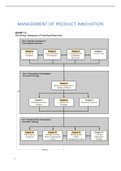MANAGEMENT OF PRODUCT INNOVATION
1
,CHAPTER 1: INTRODUCTION
THE IMPORTANCE OF TECHNOLOGICAL INNOVATION
Technological innovation = act of introducing a new device, method, or material for application to
commercial or practical objectives
introducing new products helps firms protect their margins
investing in process innovation helps firms lower their costs
THE IMPACT OF TECHNOLOGICAL INNOVATION ON SOCIETY
Technological innovation increased the amount of output achievable from a given quantity of labor and
capital
Externalities = Costs (or benefits) that are borne (or reaped) by individuals other than those
responsible for creating them.
negative externality: if a business emits pollutants in a community
positive externality: if a business builds a park in a community
INNOVATION BY INDUSTRY: THE IMPORTANCE OF STRATEGY
THE INNOVATION FUNNEL
Most innovative ideas do not become successful new products:
1/several 1000 ideas result in a successful new product: Many projects do not result in
technically feasible products and, of those that do, many fail to earn a commercial return
it takes ~ 3,000 raw ideas to produce one significantly new & successful commercial product
THE STRATEGIC MANAGEMENT OF TECHNOLOGICAL INNOVATION
firm’s new product development process should maximize the likelihood of projects being both
technically and commercially successful firm needs:
a) in-depth understanding of the dynamics of innovation
b) well-crafted innovation strategy
c) well-designed processes for implementing the innovation strategy
2
,CHAPTER 2: SOURCES OF INNOVATION
CREATIVITY
= ability to produce novel and useful work
INDIVIDUAL CREATIVITY
= function of his or her intellectual abilities, knowledge, style of
thinking, personality, motivation, and environment
Most important intellectual abilities:
a) Ability to look at problems in unconventional ways
b) Ability to analyze which ideas are worth pursuing and
which are not
c) Ability to articulate those ideas to others & convince
others that ideas are worthwhile
ORGANIZATIONAL CREATIVITY
e.g. through ‘suggestion boxes’, more advanced in forms of emails, forums, intranet
TRANSLATING CREATIVITY INTO INNOVATION
implementation of creative new ideas!
THE INVENTOR
Most successful innovators possess following traits:
1. Mastered basics tools & operations of the field in which they invent, but they have not
specialized solely in that field instead pursued 2-3 fields simultaneously bringing new
perspective to each
2. Curious and more interested in problems than solutions
3. Question assumptions made in previous work in the field
4. Sense that all knowledge is unified seek global solutions rather than local solutions & are
generalists by nature
INNOVATION BY USERS
Innovation often originates with those who create solutions for their own needs: users have a deep
understanding of their unmet needs & incentive to find ways to fulfill them
R&D BY FIRMS
Basic research = Research targeted at increasing scientific knowledge for its own sake. It may or
may not have any long-term commercial application.
Applied research = Research targeted at increasing knowledge for a specific application or need.
R&D = range of activities that extend from early exploration of a domain to specific commercial
implementations
firm’s R&D intensity has a strong positive correlation with its sales growth rate, sales from new
products, and profitability
Science push approach = innovation proceeded linearly from scientific discovery, to invention, to
engineering, then manufacturing activities, and finally marketing. According to this approach, the
primary sources of innovation were discoveries in basic science that were translated into commercial
applications by the parent firm
3
, Demand-pull model = innovation was driven by the perceived demand of potential users. Research
staff would develop new products in efforts to respond to customer problems or suggestions
Current research suggests multiple sources of info & ideas:
1. In-house R&D, incl. basic research
2. Linkages to customers or other potential users of innovations
3. Linkages to external network of firms (may include competitors, complementors & suppliers)
4. Linkages to other external sources of scientific & technical info e.g. unis and government labs
FIRM LINKAGES WITH CUSTOMERS, SUPPLIERS, COMPETITORS, AND
COMPLEMENTORS
Collaboration forms: alliances, participation in research consortia, licensing arrangements, contract
research and development, joint ventures, and other arrangements
Can pool resources (e.g. knowledge & capital)
Can share risk of new product development project
Complementors = producers of complementary goods or services (e.g., for video game console
producers such as Sony or Nintendo, game developers)
In-house R&D helps build the firm’s absorptive capacity (= ability of an organization to recognize,
assimilate, and utilize new knowledge)
UNIVERSITIES AND GOVERNMENT-FUNDED RESEARCH
Universities: Typically, intellectual property policies of a university embrace both patentable and
unpatentable innovations, and the university retains sole discretion over the rights to commercialize
the innovation
Government-Funded Research: actively invest in research through their own labs, the formation of
science parks (= Regional districts, typically set up by government, to foster R&D collaboration
between government, universities, and private firm) and incubators (= Institutions designed to nurture
the development of new businesses that might otherwise lack access to adequate funding or advice),
and grants for other public or private research entities
PRIVATE NON-PROFIT ORGANIZATIONS
E.g. private research institutes, non-profit hospitals, private foundations, professional or technical
societies, academic and industrial consortia, and trade associations
INNOVATION IN COLLABORATIVE NETWORKS
collaborations include JVs, licensing and second-sourcing agreements, research associations,
government-sponsored joint research programs, value-added networks for technical and scientific
interchange, and informal networks
Especially important in high-tech sectors (because sole company can’t afford all R&C alone)
TECHNOLOGY CLUSTERS
e.g. Silicon Valley’s semiconductor firms, Manhattan’s Multimedia cluster
government benefits of clusters increased employment, tax revenues & other economic benefits
technology clusters = Regional clusters of firms that have a connection to a common technology,
and may engage in buyer, supplier, and complementor relationships, as well as research collaboration
encompass an array of industries that are linked through relationships between suppliers, buyers
and producers of complements
WHY? Benefits of proximity in knowledge exchange
4





